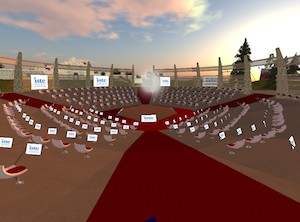 I’m a big fan of the Journal of Virtual Worlds Research – it’s not just because they’re one of the few journals around devoted to the topic, but it’s the variety of articles in each issue.
I’m a big fan of the Journal of Virtual Worlds Research – it’s not just because they’re one of the few journals around devoted to the topic, but it’s the variety of articles in each issue.
The latest volume is titled The Researcher’s Toolbox, so as you’d expect its focus is research methodologies. That said, there’s plenty of different topics to sample. I’ll showcase the couple of the articles over coming weeks as I hopefully get time to read them.
In the meantime, here’s the full list of articles:
Editor-Chief′s Corner
Virtual Worlds, the IRB and a User’s Bill of Rights
Jeffrey M. Stanton .
![]()
Peer Reviewed Research Papers
How to approach a many splendoured thing: Proxy Technology Assessment as a methodological praxis to study virtual experience
Lizzy Bleumers, Kris Naessens, An Jacobs
dint u say that: Digital Discourse, Digital Natives and Gameplay
John Grantham
A Design Research Approach to Developing User Innovation Workshops in Second Life
Remko Helms, Elia Giovacchini, Robin Teigland, Thomas Kohler
What are users thinking in a virtual world lesson? Using stimulated recall interviews to report student cognition, and its triggers
Lyn Henderson, Michael Henderson, Scott Grant, Hui Huang
Applying Constant Comparative and Discourse Analyses to Virtual Worlds Research
Peter Leong, Samuel R. H. Joseph, Rachel Boulay
Learning spaces, tasks and metrics for effective communication in Second Life within the context of programming LEGO NXT Mindstorms™ robots: towards a framework for design and implementation.
Stewart Martin, Michael Vallance, Paul van Schaik, Charles Wiz
Conducting Empirical Research in 3D Virtual Worlds: Experiences from two projects in Second Life
Shailey Minocha, Minh Tran, Ahmad John Reeves
eLab City: A Platform for Academic Research on Virtual Worlds
Thomas P. Novak
Process, Paratexts, and Texts: Rhetorical Analysis and Virtual Worlds
Christopher A. Paul
Interviews within experimental frameworks: How to make sense of sense-making in virtual worlds
CarrieLynn D. Reinhard
Using Design-Based Research for Virtual Worlds Research Projects
Antonio Santos
Research Papers
The Neil A. Armstrong Library and Archives: That’s One Small Step for a Virtual World Library, One Giant Leap for Education!
Shannon Bohle
Encouragingly, the editors are putting out a second volume of this theme due to the volume of submissions received.


Recent Comments